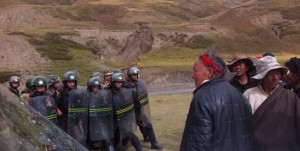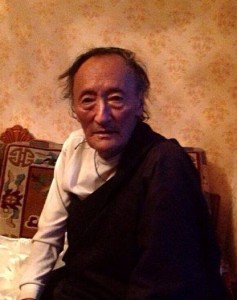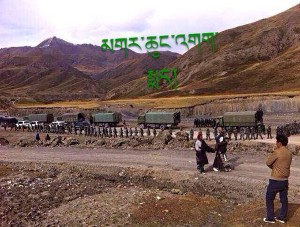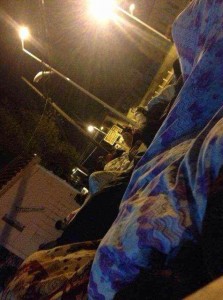
Face-off between People’s Armed Police and unarmed local Tibetans in Garchung Village in Dathang Township
Photo: TCHRD
The county of Driru in the Tibet Autonomous Region is currently under a security lockdown. People in Mowa village have refused to fly the Chinese flag from their rooftops, a space traditionally reserved for sacred prayer flags.
Chinese flags had been given out to villagers, and on September 28 a three-hour clash with the Chinese security forces was sparked when people expressed their disapproval by throwing the flags into the nearby river. Later, the army and military forces arrived. “The Tibetans who were involved in the anti-Chinese protests were threatened” said Ngawang Tharpa, a Tibetan living in Dharamsala who has contacts in the region, “[and] told they would not be permitted to pick caterpillar fungus (yartsa gunbu, a medicinal plant, and an important source of income in the area).”
On the same day, over 40 people from nearby villages Taklha, Baro, Neshod and Taring gathered to appeal to the local authorities not to use force against the Tibetans in Mowa. They were arrested. This led to a thousand Tibetans gathering outside the Chinese government administrative compound to participate in a twenty four hour hunger strike in protest against the arrests. The 40 prisoners were subsequently freed, many of them with head wounds which had been inflicted by iron batons.
In a separate incident on October 6, Chinese forces shot and wounded at least sixty Tibetans as they fired into an unarmed crowd which had gathered to demand the release of Dorje Darktsel. Dorje Darktsel had been tagged by the authorities as one of leaders who led the protests on September 28 and is currently in custody. Some of the protesters were critically wounded, includingTagyal, Tsewang and Lobsang Wangchen. Many suffered gunshot wounds to their hands and legs and were knocked unconscious when the police beat them with batons and fired teargas into the crowd, a source told Radio Free Asia (RFA).

Dayang, 68, was secretly arrested on 3 September 2013 in the middle of night from his home by a group of police in Tsachu Township, Diru County.
Photo: TCHRD
Ngawang Tharpa has also released information about Dayang, 68, who has been taken to hospital in Lhasa amid strict surveillance. He was sentenced to two years and five months in jail for shouting slogans demanding independence for Tibet in the Driru region on September 3 during a cultural performance organised by the Chinese government as part of its political re-education campaign. Dayang was reportedly beaten by security personnel.
Security in the Driru area has been severely increased, with six new check posts around the area and military camps near Mowa, Traring and Monchen villages. A source speaking to Radio Free Asia said that there are soldiers stationed outside each house in Mowa: “Villagers are not being allowed to tend to their animals, and any Tibetan found loitering in the town is now being taken away”. Other sources say that on October 4 many of the Tibetans’ mobile phones were seized and photos of the recent unrest deleted. People living in the area who have spoken to Ngawang Tharpa have likened it to the days of the “cultural revolution”.
Flying the Chinese flag on rooftops is part of the Chinese “Nine Must Haves” campaign which outlines nine essential things a Tibetan community and household must have. Since September 10 this year, over 1,800 Chinese cadres have been stationed in the Driru area to implement the campaign, along with other measures in Chinese President Xi Jinping’s “mass-line” policy.

A large number of armed police vehicles arrive in Garchung Village in Dathang Township in Driru County
Photo: TCHRD
Meanwhile, Tibetan exiles and supporters condemn the Chinese crackdown in Driru, holding a candle light vigil on October 10 on the streets of McLeod Ganj, Dharamsala. More than a hundred people, raising Tibetan flags, joined in the protest organised by Regional Tibetan Youth Congress and Students for a Free Tibet. Dorjee Tsetan, Asia Director for Students for a Free Tibet said the Driru case is an example of the spirit of Tibetans whose wish is to bring freedom for the people of Tibet and the return of the Dalai Lama to Tibet. Amnesty International has condemned the crackdown on unarmed villagers.
The Nine Must Haves
Conflict in Driru has sparked over the Chinese “Nine Must Haves” initiative, which requires, among other things, Tibetans to fly the Chinese flag from their rooftops, a space traditionally reserved for sacred flags. The “Nine Must Haves” was launched in December last year and is part of the new President Xi Jinping’s Mass-Line policy, which aims to concentrate the “masses” on correct ideas in their everyday life. Mass-Line policies range from propaganda to public administration.
1. Must have portraits of Chinese leaders
2. Must have five-starred Chinese flags
3. Must have roads
4. Must have water
5. Must have electricity
6. Must have radios and TVs [only official channels allowed]
7. Must have communication facilities
8. Must have newspapers [only official newspapers]
9. Must have cultural libraries






 Print
Print Email
Email